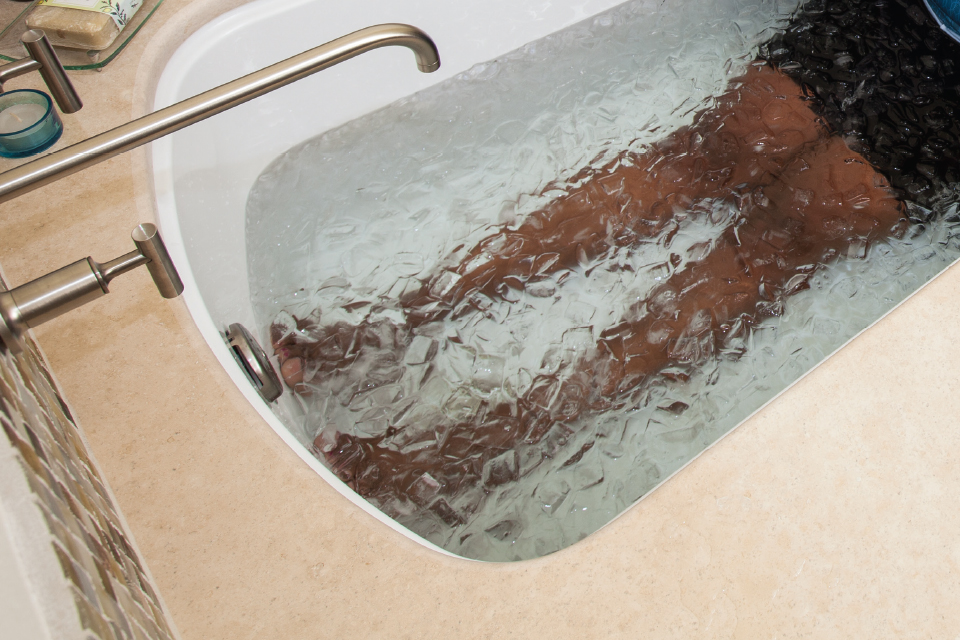Three Ways to Apply Cold Therapy

It’s hot out, so now might be a good time to try incorporating cold therapy into workout routines and in recovery.
According to numerous studies published on the National Center for Biotechnology Information (NCBI) website, cold therapy has been shown to have a positive effect on pain reduction and recovery. It’s especially suited for acute injuries, for a reduction in hemorrhaging (bleeding), edema (swelling), and in relieving arthritis discomfort. In general, it is believed that cold therapy flushes waste products from tissue and decreases metabolic activity. The effects of this treatment are dependent on how it’s applied, the initial temperature of the cold used, and the application time.
Spot Treatment
It is commonly believed that spot treatment can help with micro trauma to healthy tissues as well as help with injuries. An easy way to utilize cold therapy in this form is through ice packs and other home implements, such as the Trigger Point Performance Cold Roller (commonly used for plantar fasciitis pain). Some inexpensive and simple ways to spot apply cold are as follows:
- Freeze a paper cup two-thirds full of tap water.
- Tear away the top, exposing the ice.
- Holding onto the paper cup, rub the ice over the exposed skin.
- Massage for ten minutes or until ice melts, tearing away the rest of the cup as needed.
- Fill a plastic water bottle (leave an inch or two empty to allow for expansion) and freeze.
- Roll the frozen bottle along the bottom of the foot to help with plantar fasciitis pain.
- Mix one cup rubbing alcohol and three cups water; place in a heavy-duty plastic bag and freeze. The mixture will form slush and can be refrozen after use.
Don’t have a commercial ice pack on hand? Use bags of frozen corn or peas, especially for the eye area.
Guidelines
Apply at least three times daily for as long as there is pain, swelling, and inflammation.
Keep a cloth between ice packs left in place and skin.
Applications should not last longer than 15–20 minutes at a time, and don’t fall asleep with an ice pack on the skin.
Ice Baths
An ice bath goes a step beyond spot treatment in that a larger application area is treated and the temperature will be lower, typically about 54 degrees Fahrenheit. While many Austin-area runners swear by standing in Barton Creek or taking a dip in Deep Eddy, neither of these cooler waters (typically 70 degrees Fahrenheit) reaches the temperature of an ice bath.
Submerging areas in cold water causes blood vessels to tighten, which restricts blood flow. As the area then warms, new blood rushes in, bringing oxygenated blood to the tissues. Many athletes use ice baths to relieve delayed onset muscle soreness (DOMS), that painful achiness in muscles that comes 24–72 hours after heavy exercise.
How to take an ice bath
- Have a couple of bags of ice at the ready (an ice bucket will not provide enough ice for sufficient cooling).
- Fill the bathtub halfway full of cold water.
- Wear running shorts and top (depending on depth); have something warm to drink on hand, if desired.
- Sit in the tub so that legs are submerged and add ice to water.
- Sit in the tub for 5 to 10 minutes initially; work up to 10 to 20 minute sessions.
Cryotherapy
This method of cold therapy reduces the temperature of the entire body, bringing the skin surface temperature to 50 degrees Fahrenheit in less than a minute. Sessions last approximately three minutes.
Caulen Lauria, owner of Cryo Body Works, has worked with Paralympic snowboarder Evan Strong and F1 development driver Alexander Rossi. He noted that there are “tremendous benefits” for athletes, with as much as five times the positive effects from traditional icing. In addition to utilizing cryotherapy for recovery and to ease muscle and joint pain, Lauria pointed out that cyotherapy has also shown to be helpful in some skin conditions, such as psoriasis, itching, acne, and sunburn. The endorphins released with the intense cold can be beneficial.
Cryotherapy Treatment
- Call to schedule an appointment with a cyrotherapy studio.
- Remove clothing except for socks (and underwear, if male). Hand covers can be provided, or hands may be kept at the top (outside of) the chamber. Note: it’s important to be dry—no wet or sweaty clothes or body parts.
- Enter the chamber, a cylinder large enough to step into and stand inside. The top is open so that the head and shoulders are above the height of the machine.
- The technician will enter the room and close the chamber to begin the session.
During the session
- Cooling begins, as the temperature of the cryo chamber drops gradually but rapidly.
- Rotate slowly while breathing normally to promote an even cooling effect on the skin.
- The procedure is dry, quick (sessions are three minutes or less), and painless as the cold only penetrates 0.5 mm into the surface of the skin, keeping underlying soft tissue safe from the possibility of frostbite.
- Do not schedule a cryotherapy session if you are pregnant.
This is the most expensive cold therapy option, as treatments can start at $55 for a single session and multiple sessions are recommended (package pricing is available).






